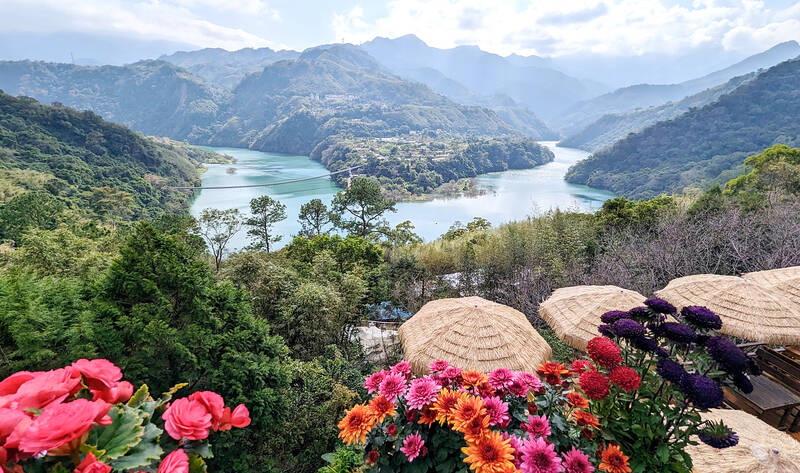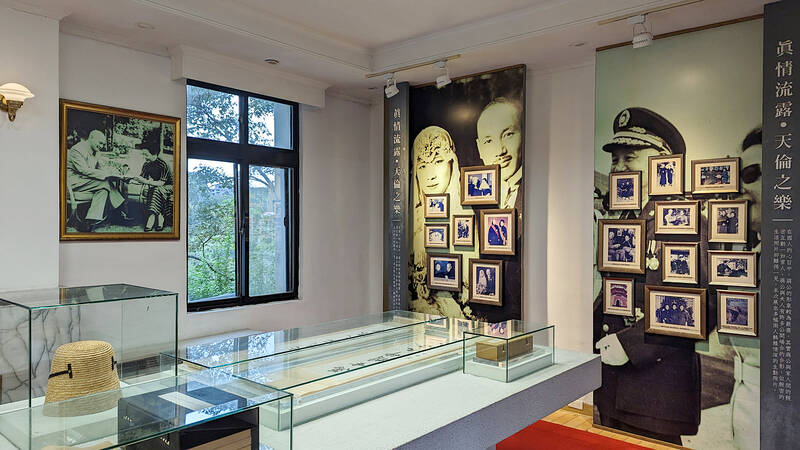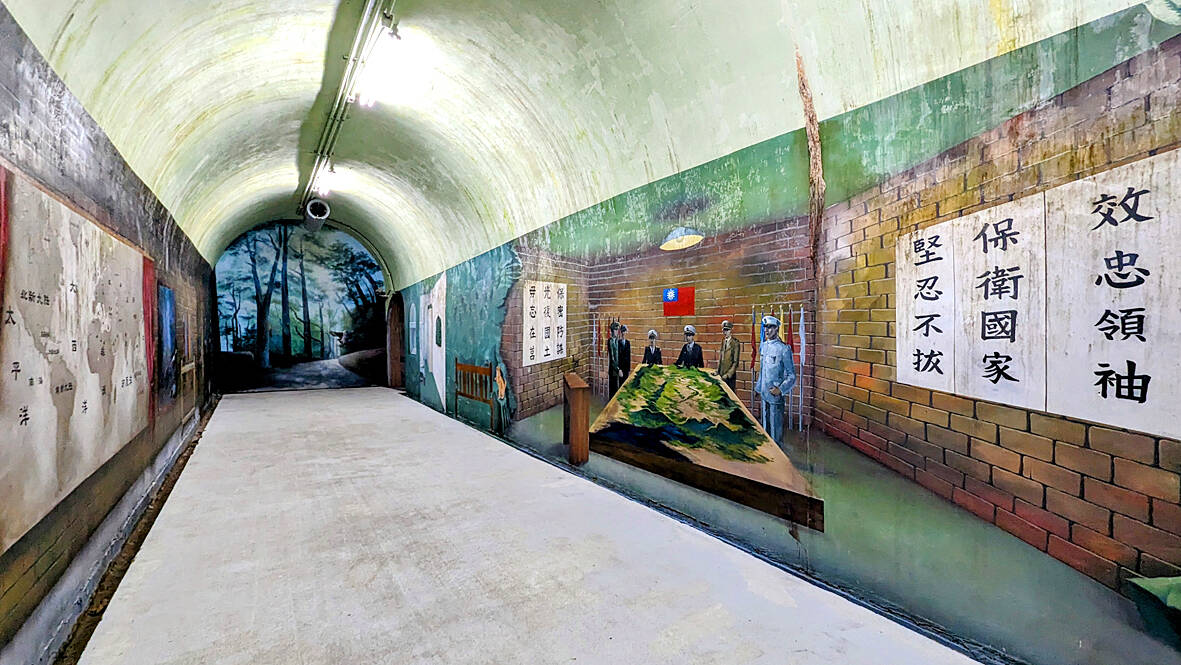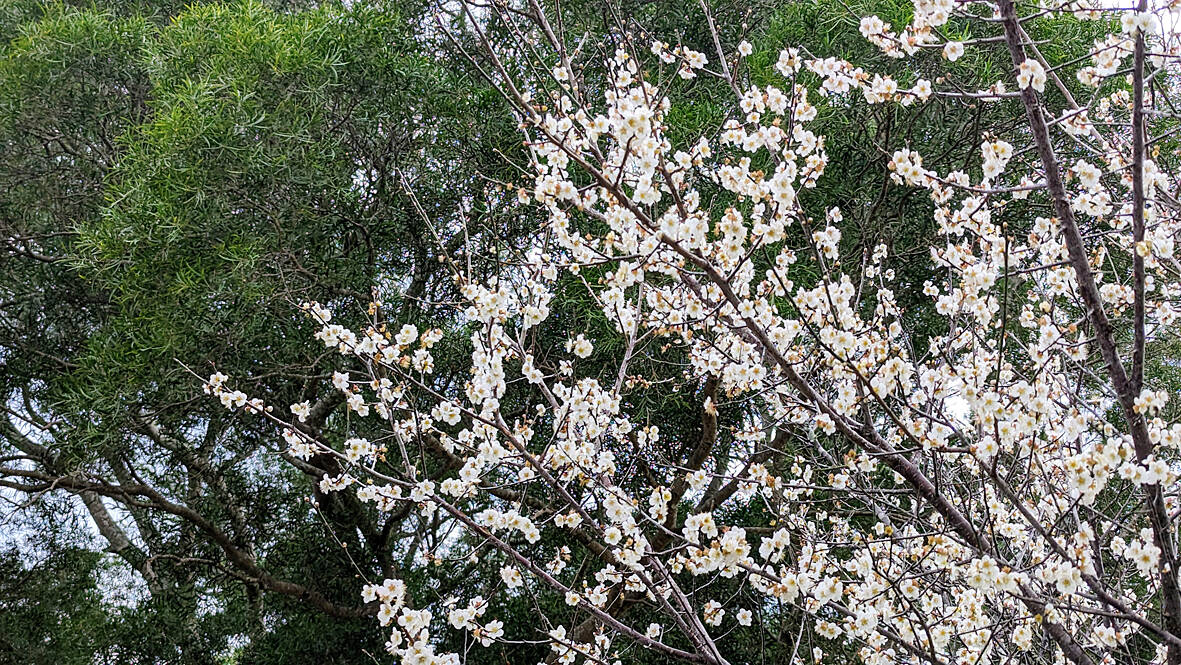The ghost of Chiang Kai-shek (蔣介石) still looms in the mountain town of Jiaobanshan (角板山) in Taoyuan County’s Fusing District (復興區). The iconic suspension bridge — the longest of its type in Taiwan at 303m — is allegedly named after his hometown of Xikou (溪口), China, and so is the indigenous Atayal village beyond it.
So explains the sign at the entrance to the bridge, but some sources such as the Taiwan Indigenous People’s Portal say that it was the Japanese who renamed the village from the original Rahaw. Xikou literally means “river mouth,” and the area is where the Shihlang River (詩朗溪) converges with the Dahan River (大漢溪).
In any case, Jiaobanshan was one of the former president’s favorite places to stay in Taiwan. The view across the river reportedly reminded him of home, and he once referred to it as his “second hometown” (although he has said that about several places). Pictures of him happily barbecuing with his family and playing with his grandsons can be seen in the exhibition hall at Jiaobanshan Park, which was revamped in late 2020. Chiang stayed at a wooden structure originally built for former Japanese crown prince Hirohito, but it burned down in 1992 due to an electrical fire.

Photo: Han Cheung, Taipei Times
Also celebrated locally is favorite son Losing Watan, an Atayal doctor, indigenous activist and provincial assemblyman who was executed in 1954 during White Terror.
Just over an hour’s drive from Taipei, the area’s rich history, hot springs and mountain scenery are definitely worth some in-depth exploration, especially if you have a car. After spending two days here, there are still quite a few things I want to return to check out.
EXPLORING XIKOU

Photo: Han Cheung, Taipei Times
Arriving in Jiaobanshan around noon, we headed straight to Forest House Cafe (森林水岸咖啡), which as several Google reviews suggested, offers okay food with amazing views. Situated on the hillside facing a bend in the Dahan River, one can see the entire valley and the impressive suspension bridge below. There’s an elevated viewing deck to get a better look.
Downhill from the restaurant is the entrance to the bridge (NT$50), reached via an unexpectedly long descent on wooden steps. Completed in 2018, the structure is surprisingly stable — I had expected it to at least shake a bit. The panoramic views are splendid, and the concrete towers of the previous bridge can be seen along the way.
Ruins of the very first bridge, built in 1922, can also be visited nearby. There’s no mention of this on site, but in town there’s a display about a terrible collapse in 1951 that killed one and seriously injured dozens.

Photo: Han Cheung, Taipei Times
Immediately on the other side is the entrance to Xikou Village, which contains an indigenous plaza with food stalls and shops. It’s very quiet past the statue of Losing Watan, and we wander up the hill to see the cute local Catholic church with good vistas of the river.
I saw a sign for an Old Canal Ancient Trail (舊水圳古道), but there was no time to hike it as the bridge closes at 4pm and we had to get back to the other side. Another place I wanted to visit is nearby Kinyawpan Village (better known as Lofu, 羅浮), where there’s a memorial park to Losing Watan. It’s also famous for its hot springs.
CHIANG’S LEGACY

Photo: Han Cheung, Taipei Times
Wander south on Jiaobanshan’s main drag, which is lined with indigenous restaurants and shops selling dried mushrooms and other goods, and hang a left before the Fuxing District Office.
Make another left at Zhongxiao Road (忠孝路) to find a “time corridor” with old photos and panels detailing the area’s history in Chinese, English and Japanese. It takes a while to read everything, but it’s definitely worth your time. You’ll not only learn about the indigenous people and their conflicts with the Japanese, but also a labor draft in 1953 to expand the road so that Chiang could enjoy a more comfortable ride in from Taipei.
This last bit is not mentioned in the Jiaobanshan Park, which includes very sympathetic photographic displays of Chiang and his family. The grounds are quite expansive, with lush plum and cherry blossoms painting the landscape white and pink. The park Web site says that the plum blossoms are in full bloom until the end of January, but there still might be some remaining. The outdoor cafe offers quality coffee and tasty dumplings.

Photo: Han Cheung, Taipei Times
The most fascinating part, however, is the escape tunnel and shelter located beneath the site. Built in 1963 and opened to the public in 2016, the 100m passageway is now adorned with 3D paintings of wildlife, indigenous culture and army imagery. It’s still rather creepy, and the large mural in the middle suggests that it was meant to be a command center in case of war. There’s also an old camphor office explaining the industry’s illustrious past here, but again we ran out of time.
HIKING AND SOAKING
To satisfy our hiking urges, we tackled Dongyan Mountain (東眼山, NT$80 on weekdays and NT$100 on weekends), one of Taiwan’s “little 100 peaks” at 1,212m. Don’t trust the time on the signs if you’re reasonably fit; it does not take seven minutes to walk 120 meters. It’s a fairly straightforward and easy hike lined with steps, and on a good day hikers can see Taipei 101 on the summit.

Photo: Han Cheung, Taipei Times
The area is also known for its odorless, sodium bicarbonate hot springs. We headed to Great Roots Forestry Spa and Resort (板根山森林遊樂園, NT$450 on weekdays and NT$550 on weekends), about 40 minutes drive up a winding road from Jiaobanshan, and had an enjoyable soak in their public pool.
The place is massive. In addition to the standard facilities and restaurants, it boasts a prehistoric animal exhibit, tea museum and will soon have a bronze museum.
There are a few forest trails within the resort grounds that contain several impressive “buttress root” trees that feature vertically compressed, plank-like roots. Unfortunately, the trail to the top of the hill was closed for renovation — another reason to visit again.

Photo: Han Cheung, Taipei Times
IF YOU GO
The fastest way to get to Jiaobanshan from Taipei is to drive. Taiwan Tourist Bus Travel Service (台灣好行) bus 502 runs on weekends and holidays from Taoyuan TRA station. On weekdays, take a bus from Taoyuan or Zhongli TRA stations to Daxi (大溪), where there are several bus options to Jiaobanshan and Dongyan Mountain. Weekend shuttles run between Great Roots Forestry Resort and Jingan and Yongning MRT stations.

Exceptions to the rule are sometimes revealing. For a brief few years, there was an emerging ideological split between the Democratic Progressive Party (DPP) and Chinese Nationalist Party (KMT) that appeared to be pushing the DPP in a direction that would be considered more liberal, and the KMT more conservative. In the previous column, “The KMT-DPP’s bureaucrat-led developmental state” (Dec. 11, page 12), we examined how Taiwan’s democratic system developed, and how both the two main parties largely accepted a similar consensus on how Taiwan should be run domestically and did not split along the left-right lines more familiar in

This month the government ordered a one-year block of Xiaohongshu (小紅書) or Rednote, a Chinese social media platform with more than 3 million users in Taiwan. The government pointed to widespread fraud activity on the platform, along with cybersecurity failures. Officials said that they had reached out to the company and asked it to change. However, they received no response. The pro-China parties, the Chinese Nationalist Party (KMT) and Taiwan People’s Party (TPP), immediately swung into action, denouncing the ban as an attack on free speech. This “free speech” claim was then echoed by the People’s Republic of China (PRC),

As I finally slid into the warm embrace of the hot, clifftop pool, it was a serene moment of reflection. The sound of the river reflected off the cave walls, the white of our camping lights reflected off the dark, shimmering surface of the water, and I reflected on how fortunate I was to be here. After all, the beautiful walk through narrow canyons that had brought us here had been inaccessible for five years — and will be again soon. The day had started at the Huisun Forest Area (惠蓀林場), at the end of Nantou County Route 80, north and east

Specialty sandwiches loaded with the contents of an entire charcuterie board, overflowing with sauces, creams and all manner of creative add-ons, is perhaps one of the biggest global food trends of this year. From London to New York, lines form down the block for mortadella, burrata, pistachio and more stuffed between slices of fresh sourdough, rye or focaccia. To try the trend in Taipei, Munchies Mafia is for sure the spot — could this be the best sandwich in town? Carlos from Spain and Sergio from Mexico opened this spot just seven months ago. The two met working in the